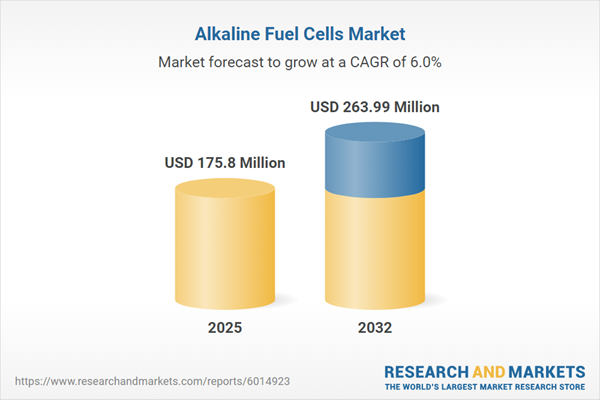Speak directly to the analyst to clarify any post sales queries you may have.
Senior executives seeking actionable insights into the evolving clean energy sector will find the alkaline fuel cells market uniquely positioned at the intersection of efficiency, scalability, and sustainability. As technological advancements and regulatory shifts converge, this market report offers a strategic resource for informed decision-making.
Market Snapshot: Alkaline Fuel Cells Market Growth and Outlook
The alkaline fuel cells market has demonstrated steady expansion, growing from USD 165.65 million in 2024 to USD 175.80 million in 2025, with a projected CAGR of 5.99% expected to reach USD 263.99 million by 2032. Multiple factors—including global decarbonization mandates, corporate sustainability imperatives, and supply chain resilience—support robust demand for both stationary and mobile fuel cell solutions. Ongoing innovation in catalyst materials and digital integration, paired with government incentives, is reshaping competitive dynamics across key global regions.
Scope & Segmentation of the Alkaline Fuel Cells Market
- Application: Backup power for data centers, residential and telecommunications; emergency power; primary power.
- Product: Motive solutions for aerospace, automotive, and marine; portable models for consumer electronics, handheld, and laptop devices; stationary systems for commercial, industrial, and residential settings.
- End User: Commercial sectors including healthcare, hospitality, and retail; industrial users in manufacturing and oil and gas; residential (multi-family and single-family); telecommunications (data centers, mobile towers).
- Power Output: High power (10-100kW), low power (under 1kW), medium power (1-10kW), and ultra-high power (over 100kW).
- Installation: Off-grid (portable and remote) and on-grid (grid-independent and grid-tied) applications.
- Hydrogen Source: Pure hydrogen and reformed hydrogen, including natural gas and renewable alcohol feedstocks.
- Regions Covered: Americas (North America: United States, Canada, Mexico; Latin America: Brazil, Argentina, Chile, Colombia, Peru) Europe, Middle East & Africa (Europe: United Kingdom, Germany, France, Russia, Italy, Spain, Netherlands, Sweden, Poland, Switzerland; Middle East: United Arab Emirates, Saudi Arabia, Qatar, Turkey, Israel; Africa: South Africa, Nigeria, Egypt, Kenya) Asia-Pacific (China, India, Japan, Australia, South Korea, Indonesia, Thailand, Malaysia, Singapore, Taiwan)
- Key Companies: AFC Energy PLC, Nedstack Fuel Cell Technology B.V., Elcogen AS, Serenergy ApS, Horizon Fuel Cell Technologies Pte. Ltd., Adelan Ltd, AlkaFuel AB.
Key Takeaways: Strategic Insights for Decision-Makers
- Alkaline fuel cells provide high operational efficiency with broad applications, including both grid-tied and off-grid scenarios across sectors such as transportation, critical infrastructure, and commercial facilities.
- Recent advancements in non-noble metal catalysts and additive manufacturing are making system integration more economically viable and scalable for diverse end users.
- Digitalization—particularly via digital twin technology and predictive analytics—is reducing operational risk and driving system performance optimization across the product lifecycle.
- Sustainability initiatives, such as circular economy principles for component recycling and electrolyte recovery, are enhancing the environmental profile for manufacturers and users alike.
- Regional policy differences necessitate localization of go-to-market strategies, with regions like Asia-Pacific benefiting from manufacturing scale while Europe and the Middle East emphasize emissions reduction.
Tariff Impact: Navigating US Hydrogen Technology Duties
Forthcoming US tariffs on hydrogen technology and alkaline fuel cell components add complexity to global sourcing and procurement. Industry leaders are responding with strategies such as nearshoring, dual-track procurement, and aligning R&D with local supply chains. These measures enhance resilience but require vigilant coordination to address shifting cost structures and timelines.
Methodology & Data Sources
This report’s findings are grounded in a dual research approach, combining in-depth interviews with senior industry and policy experts and a comprehensive literature review. Proprietary databases, regression analysis, and supply chain mapping were incorporated to verify trends and evaluate operational benchmarks, ensuring robust and actionable insights.
Why This Report Matters: Outcome-Driven Value
- Enables senior leaders to align strategic investments and R&D priorities with emerging market dynamics and evolving policy landscapes in the alkaline fuel cells sector.
- Facilitates informed risk management by providing expert analysis of supply chain disruption potential, particularly in light of tariff and regulatory changes.
- Supports the identification of partnership and innovation opportunities across new product segments and key geographic markets.
Conclusion
The alkaline fuel cells market is set to play a growing role in the pursuit of clean, reliable power. Executives equipped with timely industry intelligence will be positioned to harness emerging opportunities, adapt to regulatory complexities, and drive sustainable growth.
Additional Product Information:
- Purchase of this report includes 1 year online access with quarterly updates.
- This report can be updated on request. Please contact our Customer Experience team using the Ask a Question widget on our website.
Table of Contents
3. Executive Summary
4. Market Overview
7. Cumulative Impact of Artificial Intelligence 2025
Companies Mentioned
The companies profiled in this Alkaline Fuel Cells market report include:- AFC Energy PLC
- Nedstack Fuel Cell Technology B.V.
- Elcogen AS
- Serenergy ApS
- Horizon Fuel Cell Technologies Pte. Ltd.
- Adelan Ltd
- AlkaFuel AB
Table Information
| Report Attribute | Details |
|---|---|
| No. of Pages | 185 |
| Published | November 2025 |
| Forecast Period | 2025 - 2032 |
| Estimated Market Value ( USD | $ 175.8 Million |
| Forecasted Market Value ( USD | $ 263.99 Million |
| Compound Annual Growth Rate | 5.9% |
| Regions Covered | Global |
| No. of Companies Mentioned | 8 |









